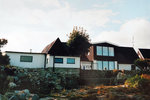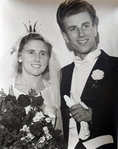






A century ago, on Jan. 11, 1922, Axel and Johanna Pettersson welcomed a baby girl into their home along the Baltic Sea on the southeast coast of Sweden, the fourth of what would grow to be a family of 10 children.
As she trudged through pastures, dodging the droppings of farm animals on her way to school in the small fishing village of Brantevik, young Emma Elizabet “Lisa” Pettersson never imagined she’d spend more than half her life in the United States.
But love changes everything, and a persistent suitor drew her across the ocean to America and Western Washington.
A week ago today, Lisa (Pettersson) Blomdahl celebrated her 100th birthday in her house overlooking her adopted home of Chehalis with her adult children, David Blomdahl and Anne Peterson. Treasured friends Suzi Vander Stoep, Hank and Jenny Kirk, and Barbara Mason stopped by.
Lisa grew up near Brantevik, once home to Sweden’s largest fishing fleet. Her bedroom looked out on the Baltic Sea, where waves froze during cold winters, creating mountains of ice. Her hardworking father, who erected a retaining wall buffering their family home from the stormy sea, delivered mail in Skåne County, Sweden — first on foot, then by bicycle and, finally, using a fleet of buses he owned and operated. Her mother cooked fresh fish, vats of Swedish meatballs and other scrumptious meals on a wood-fired stove with an oven for baking. Downstairs, electricity lit the rooms. Upstairs, her six brothers snuggled into one bedroom, their feet warmed by pitchers of hot water that froze during the night.
“I had a happy childhood,” said Lisa, who also had three sisters. “We looked up to our dad. He was special.”
So was her mother. “She looked after us. She was the most wonderful cook.”
She enjoyed helping her mother in the house, setting the table for a dozen at each meal, keeping the house nice and tidy. “I like to see things nice,” she said.
The children learned to swim in the fishing harbor at Brantevik, although she taught herself by holding onto a board and kicking. During the summers, they frolicked on the rocky shore and swam in the Baltic Sea, which warmed to nearly 70 degrees.
After seven years of education, rather than eight, she and two other girls passed exams enabling them to attend secondary school, which Lisa referred to as “college.” They rode a bus to school in nearby Simrishamn. She studied English and German, although she enjoyed German more. She enjoyed her classes and, after graduating at 17, started working for the Royal Postal Department Sweden, where post offices doubled as banks. She worked 15 years as a cashier and moved up to supervisor, sorting mail to deliver through six smaller post offices. Today, she still receives a pension from Sweden.
During the early 1940s, Lisa recalled the ceilings and walls of her home shaking when planes from Norway flew overhead and woke them up. Although both Sweden and Norway declared neutrality during World War II, the Germans invaded Norway April 9, 1940.
“We got used to it,” she said.
One morning while the family ate breakfast, a knock sounded at the door. A German man, his wife and several children stood outside, seeking asylum. Her father hurried them inside and then notified authorities.
“We weren’t allowed to help them,” she said. Her father took the family to the authorities, but they were allowed to remain in Sweden.
The Pettersson family attended a small Baptist church next to their home, where Lisa performed in a string band, singing and strumming a guitar, which her aunt taught her to play. After a long day at the post office on New Year’s Eve in 1946, Lisa refused her sister’s request to attend the Watch Night service at the church where an American evangelist was speaking.
“I was tired,” she recalled. “I said, ‘I don’t feel up to it tonight.’ But my older brother said ‘Go. It only takes an hour.’”
At the church, George Blomdahl, wearing blue pants and a sweater, spoke about the Lord, and the pastor asked Lisa to sing a song. The petite young blond played her guitar and sang in an angelic voice, drawing the interest of the Seattle native who had served with the U.S. Army Air Force in the British West Indies. After his discharge, he visited Sweden to look up relatives of his parents, Erik and Anna Blomdahl. He attended Bible College in Stockholm and spent several months traveling as an evangelist. His itinerary listed a stop at the Brantevik church. When the service ended, he approached Lisa and asked if he could see her.
“I thought he was good looking,” she recalled of the first time she saw the lanky 5-foot-11 man with brown hair and hazel eyes. “I couldn’t believe how he learned the Swedish language after he came to Sweden.”
The next morning, George knocked on the family’s door to see Lisa. He later stopped by the post office where she worked, so frequently that her coworkers teased her about it. He rode his bicycle the four miles between Simrishamn and Brantevik.
They corresponded when he returned to Seattle in 1947 to study photojournalism at the University of Washington, where he played the clarinet in the marching band, ran the photography lab and served as the school newspaper’s photographer.
After earning his bachelor’s degree, George returned to Sweden to work as a journalist and freelance photographer and resumed his relationship with Lisa.
As part of a Christian string band, Lisa traveled to small communities throughout southern Sweden, singing and playing guitar at evangelistic meetings.
“It wasn’t easy for me to think that I should leave,” she said.
Her parents liked George, she said, “but they were wondering why in the world he would spend money to go over and see a girl.”
He left again for Seattle in late January 1952 but returned around Christmas for his third trip to Sweden. After a visit from Saint Nick, the Pettersson family heard a knock on the door and opened it to find a man dressed as Santa Claus, drawing confusion as Santa had already visited. Lisa’s sister then recognized George by his neck.
While riding his bike one day, pressing against a strong wind, George prayed to God for guidance on whether to propose to Lisa. Suddenly, the wind shifted 180 degrees, and he figured God had blessed the marriage.
After seven years and three trips to Sweden, George proposed. They were engaged on May Day and married July 25, 1953, in a Lutheran church in Malmö, Sweden, a city in southern Sweden with a cobblestone square and a grand Renaissance castle erected by Danes in the 16th century.
“My mother was sickly at that time,” Lisa said. “She couldn’t come to the wedding.”
Next week I’ll share more of Lisa (Pettersson) Blomdahl’s story of her life in America.
•••
Julie McDonald, a personal historian from Toledo, may be reached at memoirs@chaptersoflife.com.